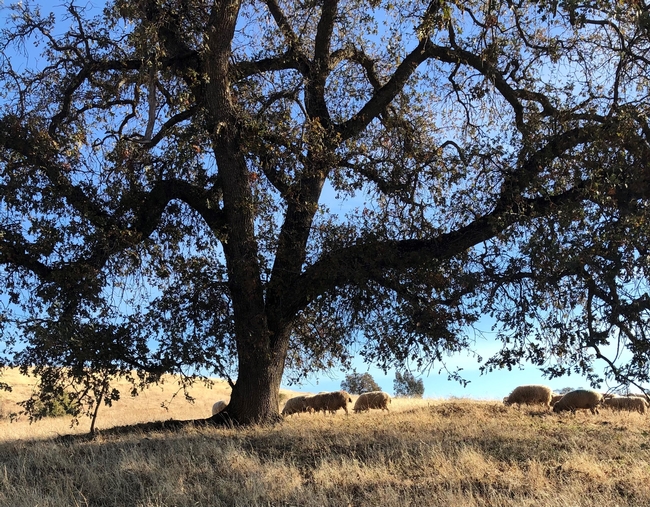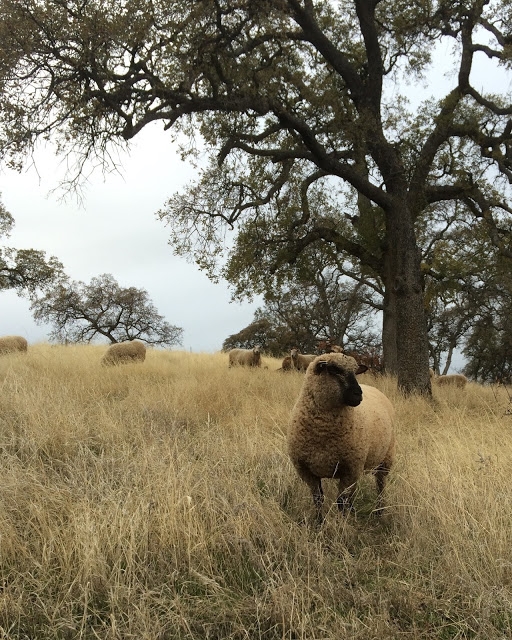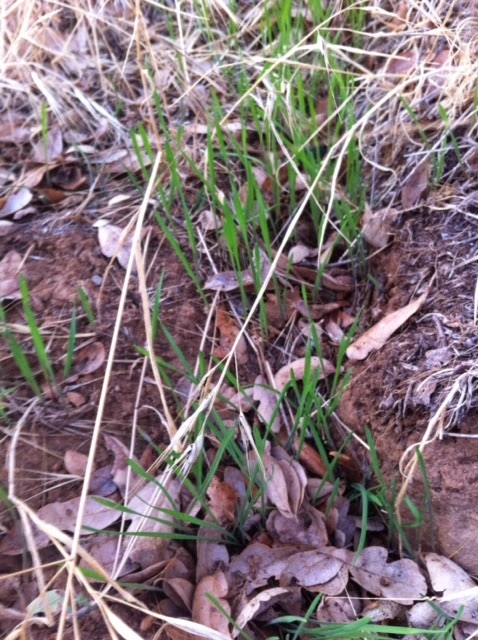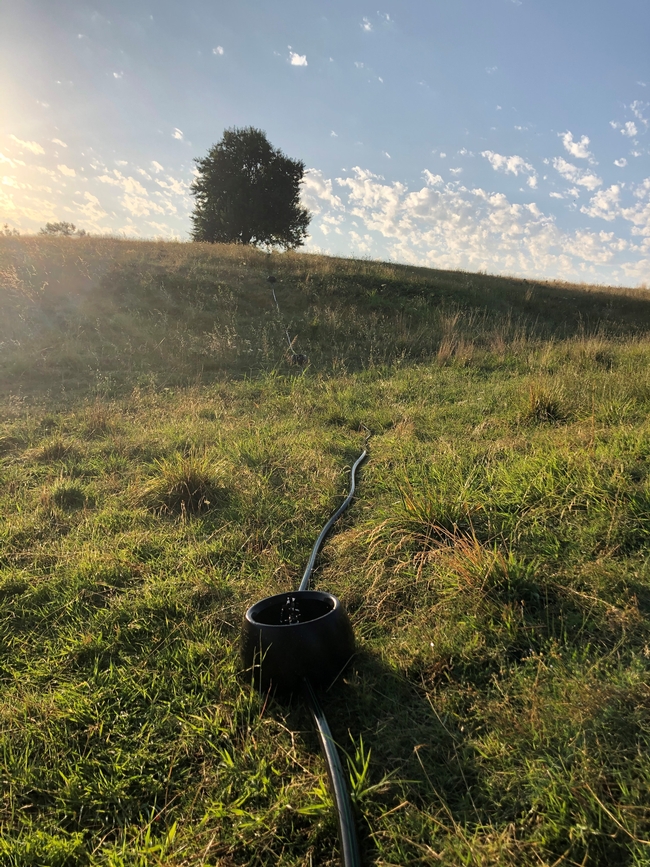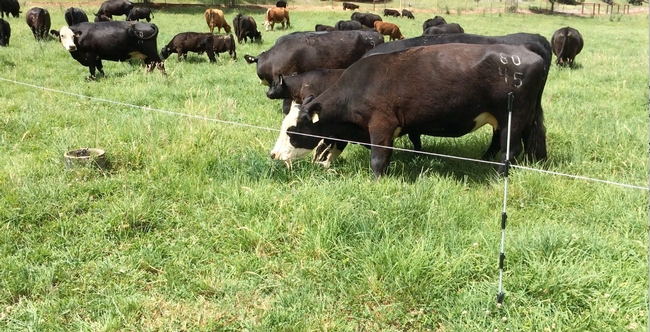- Author: Dan Macon
When we finally received a more than two inches of rain in mid-November, I was relieved that we would finally have germination on our foothill rangelands - better late than never! Today, after two weeks of sunshine, I am indeed seeing a little green coming up through last year's dry forage. But the forecast isn't promising - as of this morning (November 30), we have no rain in our forecast here in Auburn for the next two weeks. The combination of dry weather, short days, and colder (for here, at least) temperatures indicates that we won't likely grow much grass during the month of December.
Drought planning begins with proactive strategies - a conservative stocking rate, for example, or a production calendar designed to match periods of high forage demand with rapid forage growth. One of the most important proactive strategies in our small-scale sheep operation is grazing planning. Over the years, we've trained our eyes to estimate the amount of forage we have available - measured in sheep days per acre. While our estimates are not 100 percent accurate all of the time, the simple act of looking ahead and estimating the quantity and quality of standing forage gives us a better idea of when we might need to adjust our plans.
The second element of our planning process is the idea of key dates. For me, establishing a date by which we need to make a decision forces us to actually make the decision. During the 2013-2014 drought, Glenn Nader (who preceded me as UCCE livestock and natural resources advisor in Sutter and Yuba Counties) said, "The only way you're gonna survive a drought is to make decisions." This advice, obviously, has stayed with me - indecision prolongs the pain (economic and otherwise) of drought. In our operation, we look at forage conditions, weather forecasts, and our production calendar when establishing a key date. For example, our ewes will enter the last trimester of gestation in early January. At this point, their nutritional demand will begin ramping up significantly as they approach their lambing dates. While we've saved enough dry forage to get by for the next 5-6 weeks (which we can utilize by supplementing the ewes' protein intake), late gestation will require a different strategy. A key date also requires us to think about a condition that must be met for a decision to be triggered. This December, that condition is rainfall. If we haven't received an inch of rain by December 31, and if there is no rain in the 2-week forecast on that date, we'll need to make a decision.
This brings us to the last element of our drought plan - what are our options if we're still dry on New Year's Eve? For me, these reactive strategies are far less palatable - they cost us money (as in more expenses, less revenue, or both). Here are the options that are currently on the table:
- Purchase enough hay to get the ewes through late gestation and into the beginning of lambing season.
- Look for byproduct or other alternative protein and energy sources to feed the ewes.
- Sell older ewes to reduce forage demand.
- Sell replacement ewe lambs to reduce forage demand.
- Allow body condition to decline until the forage begins to grow (which may reduce lamb survival and future reproductive success).
- Find additional rangeland pasture to graze (this would still require some supplemental nutrition).
Over the next several weeks, we'll brainstorm additional options. We'll work through the economic ramifications of each of these options. We may choose a combination - perhaps we'd sell a few sheep and purchase hay to sustain the rest of the flock. The point here is that we've given ourselves a deadline for taking action, and we'll work through the numbers associated with each decision.
In the meantime, we'll keeping hoping for rain....
- Author: Dan Macon
In the meantime, how are you going to cope?
Having lived (and ranched) through California's 1000-year drought from 2012-2015, I often find myself recalling the autumn of 2013. Believe it or not, we had a germinating rain on September 3 - I measured 0.75" of rain here in Auburn. Just under three weeks later, we received another inch of rain. The combination was enough to get our grass started! But a fellow rancher - I can't remember who - told me never to trust a grass year that started before Halloween. October turned dry and November turned cold and dry - between October 1 and December 31, we measured just over two inches of rain. The grass that had looked so promising in late September was gone by New Year's Day 2014. My rancher friend was correct.
The Sierra Foothills typically experience a prolonged dry spell from late spring through early fall - part of living in a Mediterranean climate. Every autumn, I look forward to the first germinating rain - the storm that is the dividing line between brown grass and green grass on our annual rangelands. Weather forecasts from two weeks ago suggested that we'd get this storm last weekend; reality proved otherwise, and our weekend was cool but dry. And the most recent California drought map indicates that our normal dry spell has intensified into moderate-to-severe drought.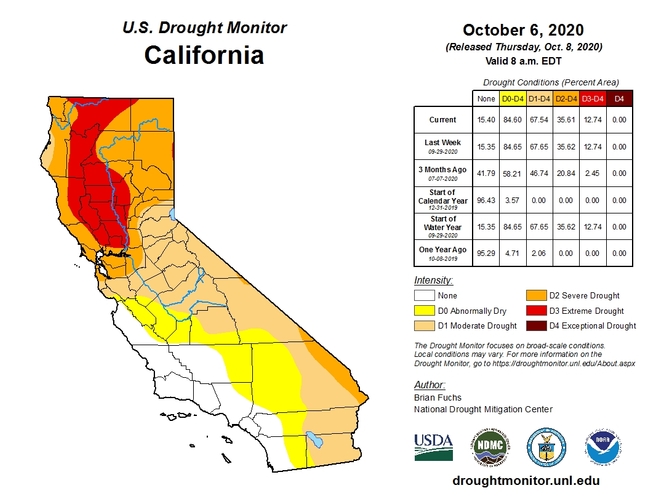
Looking back at 35 years of monitoring data from the UC Sierra Foothill Research and Extension Center (SFREC) in Browns Valley, I see a record of uncertainty and variability. The earliest germinating rain at SFREC was recorded on September 2, 2000. The latest occurred just two years later, on December 12, 2002. Over the last 35 years, the first germinating rain of the fall occurred around October 21. But in 29% of the last 35 years, a germinating rain hasn't arrived until after November 1.
Why does this matter? As most ranchers will know, we usually reach a point in mid-December when the days are too short and the temperatures (both air and soil) are too cool to support grass growth, regardless of soil moisture. I call this our winter dormant period - the timeframe where we have to get buy on the grass that grew from germination to dormancy (and last year's dry grass). If germination happens in mid-October, and we get follow-up rains, this means we have 45 days worth of growth at least. If germination happens a month later, we don't have much grass.
Because of this uncertainty and variability, most of us are conservative in our stocking rates - we keep the number of breeding animals we know we can sustain through a dry fall. Many of us use supplemental protein to be able to utilize the dry forage we saved from the previous spring. Others try to match our production cycle to the forage cycle, calving or lambing when we're likely to have adequate high quality forage.
As I think back on my experiences in 2013-2014, I think there is a difference between short-term drought and long-term drought. Our preparation strategies, like a conservative stocking rate and fitting our production calendar to the forage, help us deal with both. Response strategies, however, can be ramped up as the severity of the drought escalates. Buying supplemental feed, for example, might help bridge a dry fall; buying replacement feed to get through a dry two or three years is a recipe for bankruptcy. Similarly, deciding not to buy in stockers or feeder lambs in a dry fall is a short-term solution; selling breeding animals or replacement females is a more drastic step that might be necessary in a long-term drought.
One of the most important lessons I learned in the last drought is that we constantly need to be thinking about how much forage we have ahead of us, and talking about key decision dates. At the moment, we have enough dry grass to get through the end of January (provided we give the sheep supplemental protein). At that point, our ewes will be entering the last third of their gestation period - and their nutritional demands will start ramping up. We typically give the ewes their pre-lambing vaccines during the third week of January. If we're still dry at that stage, we'll have some difficult decisions to make. In the meantime, I'll keep doing my rain (and germination) dance! Don't worry - I won't post video!
For regular updates on forage and ranching weather conditions, check out my Instagram feed at @flyingmule!
- Author: Dan Macon
For many ranchers in the Sierra foothills and Sacramento Valley, irrigated pasture is a critical component of our annual forage calendar. In many ways, irrigated pasture has replaced the historic practice of "following the green" - of taking sheep and cattle to mountain pastures during the summer months. Green summertime forage in the foothills and valley requires irrigation in our Mediterranean climate - and so many of us spend at least part of every day from April through October spreading water across our pastures.
Here in the foothills, these pastures do more than feed livestock. Large blocks of green vegetation provide landscape-scale firebreaks that protect rural residential communities. These pastures support a great deal of wildlife, as well - I consistently see wild turkeys, blacktail deer, song birds, and hawks (just to name a few species) on our pastures near Auburn. At least to me, a well managed irrigated pasture is a cool, green jewel amidst the summer-time brown of our foothill landscapes.
Truly productive irrigated pastures don't simply appear once we start applying water, though. No matter how much I water the annual grasses that grow on our rangelands, these plants have to die each year - that's what makes them annuals! Establishing irrigated pasture is similar to planting an other permanent crop - it requires soil preparation, infrastructure development, fertilizer application, and seeding of perennial forage species (like orchard grass, fescue, and clover).
Once planted, irrigated pasture requires careful management, as well. Our irrigation system is designed to put enough water in 24 hours onto the pasture to meet plant needs for ten days (in other words, our irrigation "sets" are for 24 hours, and our "rotation" brings us back to the same location in the pasture every ten days). We also manage our grazing carefully - matching our rest periods with the growth rate of our forage. When the grass is growing rapidly in the springtime, we can graze the same paddock every 25 days; in the heat of the summer when grass growth slows, our rest periods are longer to allow the plants to re-grow before we graze them again. And to protect water quality, we try not to irrigated underneath the livestock.
Obviously, the decision to establish irrigated pasture - or to incorporate it into our production systems - must include economics! Establishing pasture - even one that will last for 20-plus years - requires significant investment. Once established, we have to pay for water, depreciate our equipment, pay for labor, PAY OURSELVES!
This spring, I collaborated with Don Stewart at the Ag Issues Center at UC Davis to update two cost studies specifically analyzing foothill irrigated pasture. Click on the links below to access them:
Sample Costs to Establish or Re-establish and Produce Irrigated Pasture - Sierra Foothills
Sample Costs to Produce Irrigated Pasture - Sierra Foothills
On a related note, I'm also collaborating with Dr. Leslie Roche, Cooperative Extension Specialist in Rangeland Management at UC Davis, along with a number of other farm advisors throughout Northern California, on a research project examining a variety of irrigated pasture management strategies. We're looking at grazing management, water management, forage production, soil health, and a variety of other parameters - stay tuned for more information on this project as well!
Now I need to go out and move water....
- Author: Dan Macon
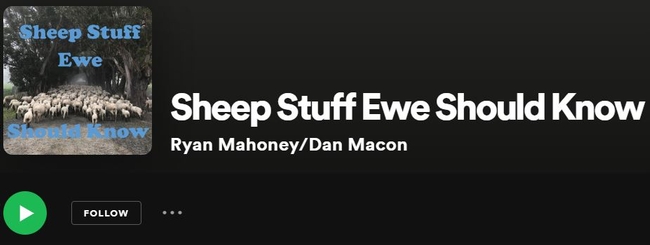
I've been fortunate to have the opportunity to get a fair bit of formal education - from my undergraduate days at UC Davis studying agricultural economics to the online coursework I took while obtaining my master's degree at Colorado State University. The certificates that hang on the wall in my office attest to this formal education; my membership in professional societies (like the Society for Range Management and Western Association of Agricultural Economics) gives me access to continued learning. My formal (and continuing) education has driven my intellectual curiosity.
Thankfully, I've also had the opportunity to learn from experience - my own and that of others. Much of what I've learned through my own experiences has been from mistakes that I've made! In many cases, I've learned what NOT to do next time. I've also had the good fortune to learn from others - from mentors (ranchers and colleagues). This informal learning is interesting - while there are times when it confirms what I've learned from books or in classrooms, it often makes me question my formal instruction. And it certainly drives my intellectual curiosity, as well.
Early on during our shelter-at-home experience this spring, my friend Ryan Mahoney, a sheep producer from Rio Vista, approached me with the idea of starting a podcast about sheep production. While Ryan operates at a very large scale (and we have a much smaller operation), we felt like we could both learn from one another. We also felt like taping a podcast would give us something to do every Wednesday afternoon! And so Sheep Stuff Ewe Should Know was born! We've now produced 12 episodes in our first season, covering topics like risk management, the effects of COVID-19 on the sheep industry, and livestock guardian dogs.
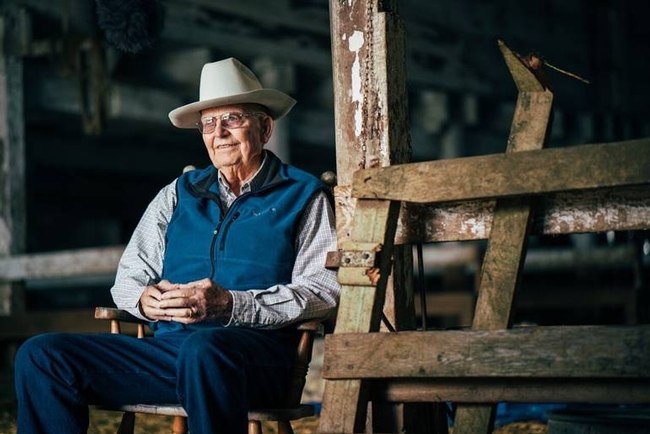
"The best sheepherder gets the most out of the land by getting the most into the sheep."
As we continue producing Sheep Stuff Ewe Should Know, Ryan and I hope to interview other producers to learn from their experiences. We'll also be talking with experts in animal health, livestock nutrition, marketing, and business management - learning from their experiences, and having fun along the way!
You can check out our podcast HERE! And let us know what topics you'd like to learn more about!
- Author: Dan Macon
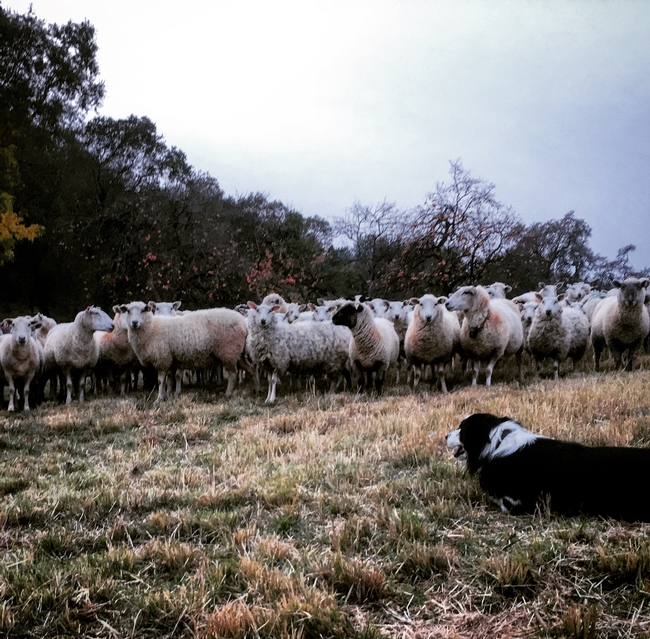
In our operation, there are several ways we can accomplish this work. We can move our portable corral system to the pasture where the sheep are grazing; we can move the sheep back to our corrals; or we can simply use dogs to bunch the sheep in the pasture and catch each animal individually. Being an agricultural economist by training (and somewhat of a economics geek), my first inclination is to compare the costs of each of these alternatives!
Option 1: Move the Corrals: We have a set of homemade portable corrals that incorporate Bud Williams' alley design (a "Bud Box" system). Two of us can dismantle, load and re-assemble this set up in about 45 minutes. This system allows us to put sheep into a race or alley to check eyes and treat infected individuals with a drench dewormer. The work of treating the 39 sheep in this bunch takes about 30 minutes. If we value our own labor at $15/hour, I estimate that this option would cost us $108 in labor (if we include the time it takes to move the corrals back to our headquarters).
Option 2: Move the Sheep to the Corrals: The lambs are currently grazing about 0.34 miles from our corrals. To walk the sheep from this pasture to our corrals, we would need to go through 5 gates and cross over land owned by four different people. The move is not terribly complicated (and our border collies love the work!), but it does take about 20 minutes to walk the sheep to the corrals to be treated - and another 20 minutes to walk them back to the pasture. Treatment time is the same as in option 1 - the total labor cost for option 2 is about $35.
Option 3: Treat the Sheep in the Pasture: My cowboy friends would call this a "rodear," I suppose - this option simply involves holding the sheep in a bunch in the pasture and catching each animal individually. For a group of sheep this size, two good dogs are sufficient. The dogs hold the sheep in a tight group. One of us catches each animal and examines the eye mucous membranes; the other person administers the drench (as needed) and marks the sheep. Any sheep showing anemia is treated with a drench; any sheep without symptoms is not treated. So that we can keep track of which sheep we've examined, we put a blue mark on the rump of those who do not need dewormer and a red mark on the rump of those we treat. Examining 39 lambs and treating those with symptoms takes about 30 minutes - our total labor cost for this option is $15. I suspect that this system is less stressful on the sheep, as well!
Obviously, this simplistic analysis doesn't capture the capital costs of acquiring and training the dogs (or of building the corrals, for that matter). Nor does it account for the cost of feeding and caring for the dogs. It also fails to account for the investment in building our own skills - I certainly could not have treated 39 lambs in 30 minutes when I started raising sheep commercially nearly 15 years ago. That said, our ability to handle livestock and use dogs effectively allowed us to treat 39 lambs before work this morning!
If you're interested in building your own stockmanship and sheep husbandry skills, there are two outstanding learning opportunities next several months:
California Sheep and Goat Grazing School (September 14-15 in Auburn, CA)
Steve Cote's Stockmanship School (October 11-14 near Wells, NV)


